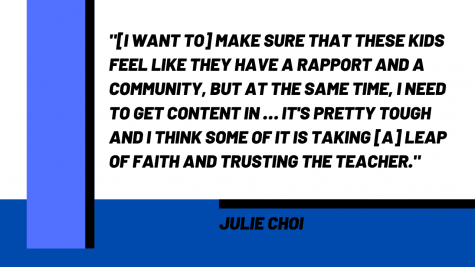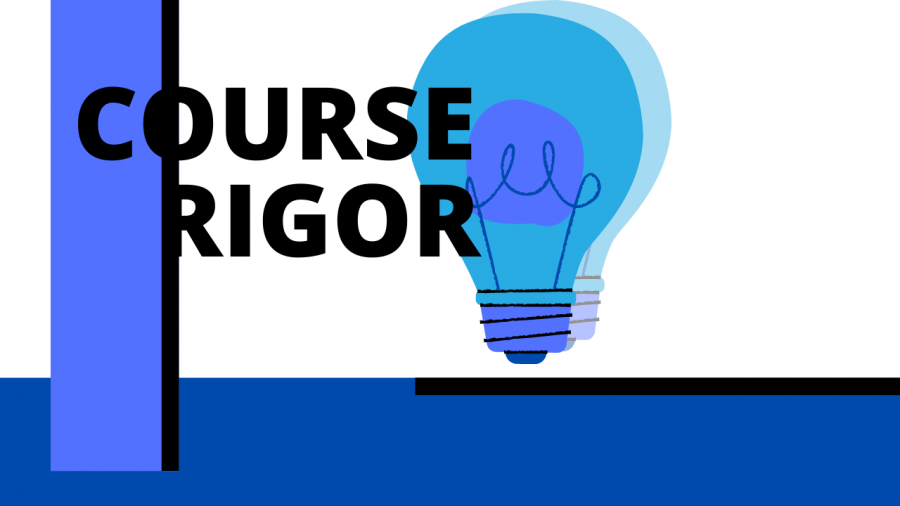Examining the impact of distance learning on course rigor
Fewer synchronous meetings and adjustments to online platforms leads to teachers determining what’s essential
Robert Liu and Abdullah Memon
COVID-19 has created a new reality for students all over the country. Many schools are now virtual — hallways once full of chatter among peers are now silent and classrooms once full of anxious teenagers now sit empty. Distance learning is the new normal for MVHS students and faculty and has brought forth various challenges, from decreased teacher-student interactions to a class schedule with fewer synchronous instructional minutes.
This is especially true for the wider curriculums of Advanced Placement (AP) and Honors level classes, which are often taught using high volumes of tests and assignments. In response, teachers have made adjustments, many of which are creating a different class experience than in previous years.
English teacher Hannah Gould is using many of her office hour slots in September for relationship-building with her current students. She believes that in these bizarre and turbulent times, maintaining and checking in on students’ social-emotional well-being is crucial to ensuring that they learn effectively.
“I think that a lot of people are feeling lonely, isolated [and] traumatized right now,” Gould said. “My number one job is to keep kids safe and make sure that they have a borderline level of physical and mental well being. If people don’t have that, then they cannot do high-quality academic work. If you neglect that, and then you ask them to do all this challenging stuff, then you don’t know [if] the problem [is of] their academic skills or some social-emotional well-being issue.”
So crucial, in fact, that Gould and the Honors American Literature Professional Learning Community plan on removing some hallmark projects like the semester-long Author Study research project to emphasize relationship-building over covering content. Gould believes that building a strong community is the first step to enabling students to reach her class’s learning objectives. This way, students will take away the same skills to tackle those projects on their own, even if they are not covered in class.
“HAmLit is a class that asks you to go deep into social issues that you have a personal stake in, and it asks you to be vulnerable and willing to talk about yourself and your own ideas and maybe risk saying something that is not [politically correct],” Gould said. “If people don’t feel comfortable and safe and [part of] a classroom community with people they know and trust, then that kind of work is impossible — it won’t even get off the ground.”

AP Chemistry teacher Julie Choi also values community, believing that building connections with each student creates a more symbiotic classroom. However, Choi cannot find herself making the same tradeoff in rigor — which she defines as the amount of content covered in a given time — that some English teachers have made.
“I really thrive on this connection with students — it’s what makes me really excited to teach and I think it’s what engages students to be motivated for my classes,” Choi said. “[I want to] make sure that these kids feel like they have a rapport and a community, but at the same time, I need to get content in … it’s pretty tough and I think some of it is taking [a] leap of faith and trusting the teacher.”
Like other AP teachers, Choi faces the problem of making sure students learn the same content for an AP test while also having fewer instructional minutes and exams. Thus, she teaches content at the same pace as in previous years, just without the same grade rigor.
“I’ve been forgiving about certain things — if you turn in their homework late right now, I’m letting it go,” Choi said. “But in terms of the rigor that I teach at, I don’t think it’s any different. I don’t speak for every kid, but for the typical AP student — I was one of them at one point or another — I think they care about it. That’s why they spent [a hundred dollars] to take this test.”
Senior Dhanush Ramkumar’s experiences so far in various APs this year reflect this. In AP Physics C and AP Calculus BC, for example, he notices a stronger emphasis on flipped learning, likely intended to fit in the same amount of content as previous years.
“I personally don’t really find much of a difference, because in school, especially AP courses and Honors courses, it’s expected [that you] learn at home and then go through all your questions at school,” Ramkumar said. “And that format is still held in distance learning. So most of my learning actually comes from my friends, [whom] I still have contact with.”
For some of his classes, this creates a homework load similar to previous years, despite fewer instructional minutes.
“[Some classes are] just as rigorous — it’s just not as stressful because you’re not as pressurized by tests,” Ramkumar said.
“I feel like students should be able to learn just as much as they do in previous years. It’s just [that] before, there was a lot of pressure on them because they are expected to do well on tests, but this year, it’s more of their own responsibility to learn the subject.”
Ramkumar says that this dwindling attention on traditional exams marks a change in attitude on the definition of course rigor at MVHS, yet according to Gould, this doesn’t necessarily impact students negatively.
“These circumstances are … forcing teachers to decide which are the most essential skills and teach more thoughtfully toward those, instead of piling on work,” Gould said. “There’s a lot of evidence that shows just asking kids to do more and more and harder and harder doesn’t actually help them very well, and it can benefit people to learn more deeply something that is more essential instead of trying to learn everything.”
Gould is optimistic that distance learning may even benefit students in the long run.
“I think it might be a net gain across the board with all of the classes — even if there’s maybe one or two classes where it’s like, ‘oh we missed this cool opportunity to do this one cool project,’” Gould said. “If kids are getting more and more equitable benefits from all of their courses, that will benefit everybody in really big ways.”
El Estoque • Copyright 2025 • FLEX WordPress Theme by SNO • Log in

